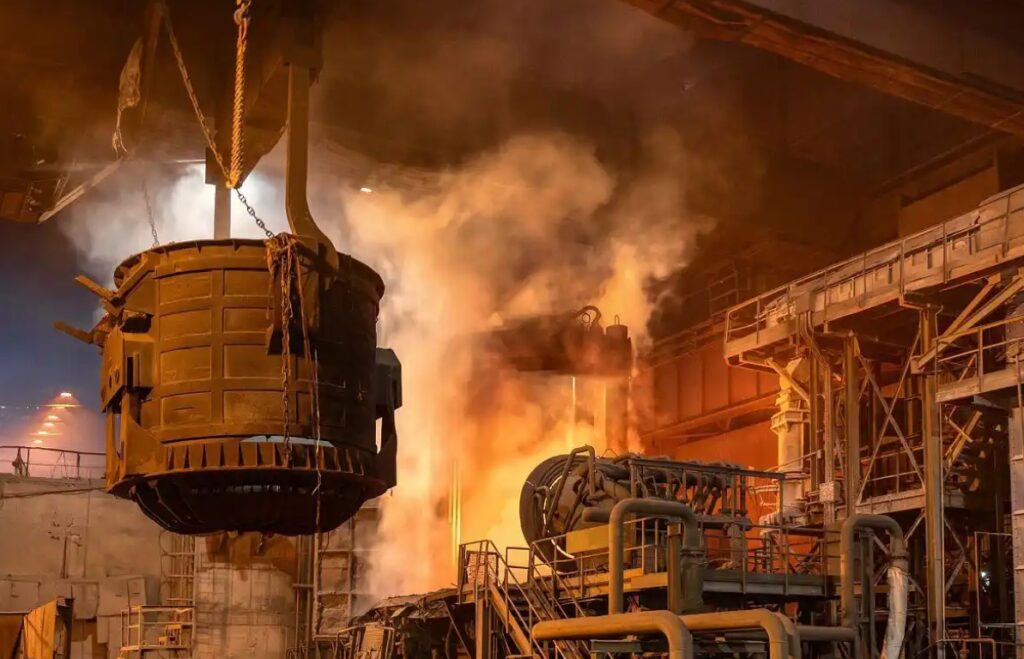The Asian Development Bank (ADB) released a report projecting that Southeast Asian countries will achieve economic growth rates of 4.6% and 4.7% in 2024 and 2025 respectively, both higher than the 4.1% level recorded in 2023. The economic growth rates of the vast majority of Southeast Asian countries are expected to exceed last year’s figures this year and next. Among these countries, Vietnam, the Philippines, Cambodia, and Indonesia are leading in terms of growth momentum.
The Southeast Asia Iron and Steel Institute (SEAISI) estimates that steel demand in the Southeast Asian region will reach 79.5 million tons in 2025, representing a year-on-year increase of 3.7%. According to SEAISI statistics, in 2023, the total steel demand of the six major steel-consuming ASEAN countries (ASEAN-6) stood at 73.5 million tons, a year-on-year decline of 1.9%; total production was 49.4 million tons, down 2.1% year-on-year; and total net imports were 24.3 million tons, a year-on-year decrease of 1.3%. Currently, steel demand in the Southeast Asian region is primarily concentrated in the construction industry, focusing on long products and flat products. Among these, the self-sufficiency rate for long products is generally high, but flat products remain highly dependent on imports. It is projected that the compound annual growth rate (CAGR) of apparent steel consumption in major steel-using ASEAN countries from 2022 to 2026 will reach 3.65%.
I. Overview of Vietnam
Since implementing its economic opening-up policy in 1985, Vietnam’s economy has consistently maintained steady positive growth. It not only successfully weathered the impacts of the 1999 Asian financial crisis and the 2008 global financial crisis but also demonstrated remarkable resilience amid the severe challenges posed by the 2019 pandemic. During the period from 2000 to 2020, Vietnam’s economy achieved rapid development, with an average annual GDP growth rate of 7.37%, ranking among the top in ASEAN countries. Currently, Vietnam has a population of over 97 million, with a per capita income of approximately $4700 and a total GDP of approximately $476.3 billion by 2024.
Vietnam’s economic structure is undergoing rapid transformation and upgrading. In 1985, agriculture dominated its economic system. However, following the reform and opening-up, Vietnam gradually shifted toward industrialization. Notably, since 2000, the service sector has emerged as a key driver, maturing the overall economic structure. Today, agriculture accounts for about 15% of Vietnam’s economy, industry for 34%, and the service sector for 51%.
Vietnam’s apparent crude steel consumption has reached 23–25 million tons, ranking first among ASEAN countries. This figure underscores the significant progress Vietnam has made in industrial development, particularly in sectors with high steel demand such as manufacturing and construction.
II. Vietnam’s Steel Industry
(1) Steel Production Capacity
Vietnam has total iron ore reserves of approximately 2.3 billion tons. Steel mills are mainly distributed in industrial zones around Hanoi and in the Dong Nai border area, following the distribution of mineral resources. The Vietnamese government imposes strict legal restrictions on iron ore mining and utilization, and the quality of mined ore is relatively poor; thus, iron ore is still partially imported from Brazil and Australia. In 2024, Vietnam’s crude steel capacity is 30 million tons, including an annual hot-rolled coil capacity of 8-9 million tons and an annual construction steel capacity of approximately 15 million tons. It is expected that only 5.6 million tons of capacity will be put into operation in 2025 during the 2023-2030 period.
Vietnam’s crude steel output has generally maintained a growth trend. In 2023, affected by the downturn in the real estate sector, Vietnam’s crude steel output was 19 million tons, with finished steel output reaching approximately 29 million tons. Among these, long products (wires, rebar, sections) accounted for 12.5 million tons, while hot-rolled coils and strip steel totaled around 6 million tons. In 2024, crude steel capacity is 30 million tons, with the top five enterprises (CR5) holding a market share of about 54%. The plan is to reach 50-60 million tons of capacity by 2030. Due to an underdeveloped domestic scrap steel recycling system and low ore grade, Vietnam relies on imports for 40% of its iron ore and 87% of its coking coal, primarily from Australia, China, and other sources.
(2) Major Steel Enterprises
A. Vietnam Hoa Phat Steel (Hoa Phat)
Hoa Phat Group is Vietnam’s leading steel producer and one of the country’s most promising and competitive private enterprises. Established in 1992, the group was restructured and listed on Vietnam’s stock market in 2007 (Hoa Phat Group JSC). Hoa Phat operates in steel manufacturing, mineral mining, coking coal production, real estate, furniture, and construction machinery, with factories located in provinces and cities such as Hanoi, Hung Yen, Hai Duong, Lao Cai, An Phu, Ha Giang, Ho Chi Minh City, and Binh Duong. Its annual steel production capacity is approximately 7.2 million tons.
B. Formosa Ha Tinh Steel Corporation (FHS)
Established in 2008 and headquartered in the Yong An Economic Zone of Ha Tinh Province, FHS is a large-scale steel enterprise jointly established by Taiwan’s Formosa Plastics Group in Ha Tinh Province. It is also one of the largest foreign direct investment (FDI) projects in Vietnam’s history. FHS focuses on the production and sale of various steel products, including crude steel, hot-rolled coils, and wires. Additionally, the project constructed the Sơn Hưng International Deep-Water Port to support its steel production facilities. Currently, FHS has completed Phase I, which includes two blast furnaces with a total annual capacity of 7.5 million tons. In 2019, FHS announced two expansion plans: the first involves investing in the construction of Blast Furnace No. 3 (including auxiliary engineering systems) from 2021 to 2025, aiming to increase total annual capacity to 10.4 million tons; the second involves building Blast Furnace No. 4 and auxiliary systems from 2026 to 2035 to further boost capacity to approximately 14.8 million tons annually.
C. Vietnam Steel Corporation (VNSteel)
VNSteel is Vietnam’s largest steel enterprise, established on October 1, 2011, through the restructuring and integration of former state-owned enterprises. Headquartered in Lang Ha Ward, Dong Da District, Hanoi, the company centers on steel smelting, with an annual production capacity of 1.5 million tons of billets and over 2.5 million tons of rolled steel.
D. Lao Cai Iron and Steel Plant
Construction of the Lao Cai Iron and Steel Plant began in April 2011 and was completed in 2014. With a total investment of over $335 million, the project is a joint venture between Vietnam Steel Corporation and China’s Kunming Iron and Steel Group. The plant has a daily output of approximately 1,200 tons of billets. Construction was divided into two phases, with the completed Phase I achieving an annual output of 500,000 tons of iron and 500,000 tons of billets.
E. Vietnam Thai Nguyen Iron and Steel Plant
Since its groundbreaking in 1959, the plant officially began operations in 1963, with an annual production capacity of approximately 500,000 tons.
(3) Competitive Landscape of the Steel Market
Vietnam’s metallurgical and casting market has evolved into a three-way competitive landscape dominated by local giants, Chinese enterprises, and multinational groups:
A. Local Leading Enterprises
Local leaders represented by Hoa Phat Steel, Hoa Sen Steel, and Vietnam Steel Group dominate the construction steel market through cost advantages (product prices are 5-8% lower than those in China) and government support. These enterprises are penetrating high-value-added product sectors through technical cooperation with Chinese and European firms. For example, the Hoa Phat Group’s collaboration with MCC Southern to build the Rung Gio Steel Plant, targeting an annual capacity of 6 million tons, is poised to become Southeast Asia’s largest steel base.
B. Multi-Dimensional Layout of Chinese Enterprises
Chinese companies have established a multi-layered presence across Vietnam’s metallurgical industrial chain:
- Engineering Contracts: MCC Southern has undertaken the EPC turnkey project for Hoa Phat’s Rung Gio Steel Plant, driving exports of Chinese equipment and technical standards.
- Capacity Investment: Formosa Ha Tinh Steel has introduced Chinese technology to produce high-value-added automotive steel and home appliance steel.
- Local Manufacturing: Hebei Guangde Fluid Technology from China invested $12 million in Ba Ria-Vung Tau Province to establish a factory producing 500,000 sets of valves annually, serving the Southeast Asian market.
- International Enterprises’ Technological Dominance
European engineering technology companies such as Siemens-MARCELS, Danieli, and Primetals Technologies maintain advantages in high-end metallurgical equipment, particularly in precision control areas like continuous casting and rolling, and automotive steel production. However, Chinese enterprises are narrowing the gap in terms of cost-effectiveness and localized services.
III. Vietnam’s Steel Demand
Vietnam is the largest steel consumer in Southeast Asia. The Vietnamese government has consistently promoted large-scale infrastructure development, maintaining infrastructure investment at 10% of GDP from 2011 to 2023. Preliminary statistics show that Vietnam’s GDP rose to $430 billion in 2023, representing a year-on-year increase of 5.05%, with an average annual compound growth rate of 4.66% from 2019 to 2023. Therefore, as Vietnam’s GDP continues to grow, its stable infrastructure investment is expected to support steady growth in steel demand.
According to statistics released by the Vietnam Steel Association (VSA) in 2022, the construction industry dominates steel consumption in Vietnam, accounting for approximately 89% of total consumption. Household appliances account for 4%, machinery for 3%, and automobiles, petroleum, and natural gas each for 2%. It is evident that the construction industry is Vietnam’s most critical steel-consuming sector, contributing nearly 90% of total consumption. In Vietnam, the development of the construction industry directly influences the dynamics of the entire steel demand market.
The construction industry’s dominance in the steel market has driven growth in long product production and led to overcapacity, prompting Vietnam to divert excess capacity through exports. Overall, Vietnam’s dependence on foreign steel is 30%. Weak production capacity in flat products has resulted in a high reliance on imports for this category. Vietnam’s apparent consumption of finished steel reached 22 million tons in 2023, and it is projected to increase to over 23.3 million tons by 2025, ranking first among ASEAN countries.
The Vietnamese government plans to invest $140 billion in infrastructure development over the next 5-10 years, covering the expansion of transportation networks, development of industrial zones, and urban construction projects, which will directly drive growth in the consumption of construction steel, pipes, and structural steel. As an important base for automobile manufacturing and home appliance production in Southeast Asia, Vietnam has a high dependence on imports of mid-to-high-end steel products such as cold-rolled sheets and galvanized sheets.
IV. Shortcomings of Vietnam’s Steel Industry
High-end products rely on imported technology, resulting in a “polarized” technological landscape in Vietnam’s metallurgical casting industry, with significant generational gaps in technical capabilities between domestic enterprises and foreign-invested firms.
Technical bottlenecks of domestic enterprises: There are over 100 large-scale metallurgical and steel enterprises nationwide, 80% of which are electric arc furnace (EAF) steel plants, primarily relying on imported scrap steel for reprocessing. Domestic casting processes still primarily use traditional sand casting, with an automation rate of less than 30%. As a result, products are mostly concentrated in low-value-added categories such as construction rebar and angle steel, while there is a severe shortage of capacity for high-precision castings required by the automobile and machinery manufacturing industries. Vietnamese foundries generally face three major challenges: a shortage of skilled technical workers, weak independent innovation capabilities, and horizontal competition, which constrain the pace of industrial upgrading.
Accelerated international technology input: Technology exports from Chinese and European enterprises are transforming Vietnam’s metallurgical landscape. A typical example is the Rung Gio Steel Plant built by MCC Southern for Vietnam’s Hoa Phat Group. This project introduced China’s independently developed automatic steelmaking system, rotary sub-lance technology, and typhoon-resistant construction techniques (capable of withstanding 17-level typhoons), reducing the mill’s maintenance cycle from 10-15 days under traditional processes to 4-5 days. In the casting sector, 3D sand printing technology represented by Beijing Sande Technology is beginning to gain traction in Vietnam. Its 3DPTEK-J2500 equipment achieves a printing accuracy of ±0.3mm, reducing the development cycle of complex castings by 85% and lowering costs by 30%, making it particularly suitable for the production of precision castings such as new energy vehicle components.
V. Vietnam’s Steel Imports and Exports
Preliminary data from the General Department of Customs of Vietnam shows that in April this year, Vietnam’s steel exports remained stable compared to the previous month, while both steel and scrap steel imports declined rapidly. April’s exports reached 1.11 million tons, a mere 0.9% increase from March. Meanwhile, export values remained stable, reflecting steady export prices over the past two months. Compared with the same period last year, exports increased by 14.4%.
Total exports in the first four months of this year surged by 33.7% year-on-year to 4.34 million tons, with export values surging by 28.1%. In April, Vietnam imported 1.28 million tons of steel, a month-on-month decline of 10.7%, but a year-on-year increase of 24.3%. Total imports from January to April reached 5.37 million tons, with imports in this period increasing by 42.5% compared to the same period last year.
Customs data shows that in April 2024, Vietnam’s imports of hot-rolled coil (HRC) continued to rise, reaching 890,000 tons. Of these, 71% were imported from China. Cumulatively, over the first four months of 2024, Vietnam imported 3.93 million tons of hot-rolled steel, a 32% increase from the same period in 2023, equivalent to 159% of the domestic hot-rolled coil industry’s total output. Imports from China accounted for 73% (2.9 million tons), more than doubling the same-period figure in 2023.
In 2023, Vietnam became China’s largest steel export destination, with imports rising by 69.5% year-on-year to 9.249 million tons. In 2024, exports to Vietnam reached 12.738 million tons, accounting for nearly 50% of China’s total steel exports. According to Vietnamese media reports, the import price of Chinese hot-rolled coil is 32-59/ton lower than the average price in other markets. Compared with hot-rolled steel imports from South Korea, Chinese hot-rolled steel is 32−59/ton lower than the average price in other markets.Compared with hot−rolled steel imports from SouthKorea,Chinese hot−rolled steelis 123/ton cheaper.
In 2024, Vietnam’s steel exports to the U.S. increased by 143.4% year-on-year to 1.2 million tons, with galvanized steel accounting for 35% (approximately $1.2 billion in export value). The U.S. is one of Vietnam’s key steel export markets. Vietnam also exports steel coils, galvanized sheets, and other products to ASEAN countries (such as Indonesia and Malaysia), with these exports accounting for about 30% of its total exports. The EU is another major market for Vietnamese steel exports, with key products including steel coils and galvanized steel sheets.
VI. Policy Framework of “Encouragement and Restrictions Coexisting”
A. Foreign Investment Incentives and Localization Requirements: Vietnam’s Investment Law provides tax incentives for foreign enterprises in high-tech sectors such as new energy vehicle battery factories under a “four-year exemption followed by nine-year halving” policy—corporate income tax is exempted for the first four years from profit generation, and the tax rate is halved (minimum 5%) for the subsequent nine years. However, foreign enterprises must meet industry-specific localization rate requirements. For government infrastructure projects, foreign enterprises are required to cooperate with Vietnamese partners and complete substantial processing in Vietnam to qualify for bidding.
B. Stricter Environmental Regulations: Vietnam’s 2020 Environmental Protection Law mandates that steel mills install desulfurization equipment, significantly increasing compliance costs. Additionally, to address the EU’s Carbon Border Adjustment Mechanism (CBAM), Vietnam is promoting low-carbon technologies such as electric arc furnace (EAF) steelmaking and hydrogen-based metallurgy in the steel industry, aiming to achieve carbon neutrality by 2050.
C. Special Support for the Aluminum Industry: The Vietnamese government has implemented special incentives for the aluminum processing industry, including: zero tariffs on high-end aluminum processing equipment worth over $1 million that falls under the Priority Development Technology List and cannot be produced domestically; exemptions or reductions in export taxes for deep-processed products exported to the EU and ASEAN countries; anti-dumping measures on imported aluminum materials; and financial credit support policies. These policies aim to attract foreign investment and domestic enterprises to collaborate in building an aluminum industrial cluster, shifting from raw material exports to high-value-added processing.
Sinosteel Stainless Steel Pipe is the Manufacturer and Supplier of Stainless Steel Pipe and Special Alloy Pipe, Steel pipes with an outer diameter from 8mm to 3600mm, with wall thicknesses from 0.2mm to 120mm. Factory covering an area of 333,000 square meters. Production capacity reaches 200,000 tons.



